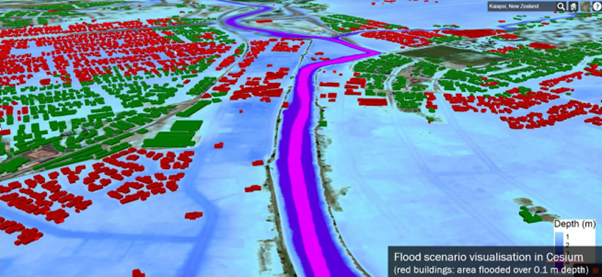Rethinking the future of New Zealand infrastructure
Professor Larry Bellamy from the University of Canterbury is heading up an 8-year industry-led applied research programme that is responding to the massive challenges facing New Zealand’s infrastructure sector.
On this page
The New Zealand Infrastructure Commission recently priced the country’s deficit at around $1 trillion over the next 3 decades. That’s the investment needed to get our infrastructure up to the standard of similar OECD countries. It’s also the equivalent of making the complete Lord of the Rings film trilogy, 33 times, every year, for 30 years.
There is no movie magic in national infrastructure. From our pipes and roads to our houses and hospitals, the challenges the sector faces need a more sensible and sustainable solution than simply spending more.
That is where Professor Larry Bellamy and the Building Innovation Partnership programme come in. With a funding envelope made up of $7.5 million from private investment and $5 million from the Government’s Partnerships Scheme, as well as a roster of experts crossing the boundaries of academia and industry, the Building Innovation Partnership programme is casting new light on the future of infrastructure engineering in Aotearoa New Zealand.
Solving problems with innovation and collaboration

Dr Larry Bellamy was involved in the setup of Building Innovation Partnerships in 2018.
The Building Innovation Partnership was initiated in 2018 by the University of Canterbury Quake Centre, set up after the Canterbury earthquakes to generate engineering knowledge needed for the rebuild of the city.
“UC Quake Centre leaders and industry partners recognised that new knowledge was needed in many areas to improve the technical and economic performance of New Zealand’s buildings and infrastructure,” Dr Bellamy says.
“It was widely recognised that the infrastructure sector was ripe for innovation – and not just in earthquake engineering – so the Building Innovation Partnership was created.
“From the outset, this was a collaborative effort primarily between industry and the universities of Canterbury and Auckland.”
As an applied research programme, the Building Innovation Partnership is driven by the needs of the sector. Across 4 research themes, the programme is helping the infrastructure industry to:
- use data to make better investment decisions
- use digital solutions that improve the construction and performance of infrastructure
- improve the resilience and sustainability of buildings
- reduce carbon emissions.
“Within the first theme, we have focused on New Zealand’s water infrastructure, including underground pipe conditions, their risk of failure, and urban flood risks and mitigations.
“This work is making better use of infrastructure-related data and data analytics to improve decision-making and is breaking new ground on incorporating well-being into infrastructure investment decision-making.”
The projects coming out of the digital engineering theme are each accelerating the uptake of digital technologies to improve coordination, communication and decision-making in various ways. Dr Bellamy enthusiastically describes a digital twin pilot which involves developing and testing a virtual model of an urban flood for the Otakaro River in Christchurch.
“Digital twin technology brings together computational models of flood inundation with other data for hazard assessment, management and mitigation,” he explains.
“A key objective for this project was to enable faster assessment of flood risk through automation of hydrological data inputs into computer simulation models.
“This technology is exciting because it has the potential to change the way flood mitigation plans are developed and communicated, helping to improve the resilience of communities to climate change.”

The programme successfully developed and demonstrated a prototype digital twin for a site north of Christchurch.
Within other themes, Building Innovation Partnership is exploring opportunities to innovate and developing practical solutions that address other pressing infrastructure needs.
“We’re developing strategies to protect valuable non-structural elements along with the primary structure of earthquake-prone buildings, accounting for carbon emissions associated with different strengthening strategies with a whole-building approach. And we’re taking a systems approach to the production of building materials and the supply of energy to urban communities, which means developing strategies for reducing the embodied and operating carbon emissions of buildings.”
Putting new knowledge to work
A programme of this size and scale does not come without its challenges. For one, industry acceptance and uptake of new ideas and technologies has been something Dr Bellamy and his team have had to address head on.
“Where possible, industry experts are embedded into our project teams to help ensure our work is well targeted and relevant to them,” he says.
“A highlight for me was getting representatives from the concrete industry around the table to collectively agree on a decarbonisation strategy for New Zealand concrete. The development and launch of the Net-Zero Carbon Concrete Industry for Aotearoa NZ: Roadmap to 2050 was an extremely positive achievement for everyone involved.”
Government funding has also been crucial to the success of the research programme.
“MBIE’s Partnerships Scheme proves an effective model for attracting and utilising research investment from the building and infrastructure sector.
“It has helped to de-risk the projects we are undertaking to the point where industry has found it attractive to invest in them.”
Dr Bellamy is confident that Building Innovation Partnership will help New Zealand become a world leader in the use of data and digital technologies for infrastructure planning, design, construction, maintenance and service delivery.
“It’s our hope that this will make our infrastructure more affordable, resilient and fit-for-purpose,” he says.
In the final stages of the programme, Dr Bellamy says the focus is on ensuring the latest Building Innovation Partnership research is implemented and adopted. From there, as the inaugural Ada Rutherford Professor of Architectural Engineering at the University of Canterbury, his work lifting the skills and capability of the building and infrastructure sector is sure to keep building innovation and partnerships that last long into the future.

